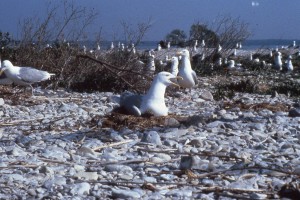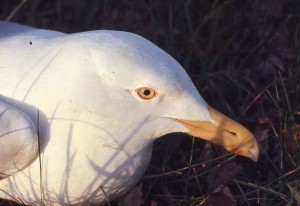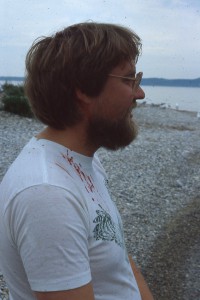by William C. Scharf
It’s early on a clear, sunny morning in mid-April. Lake Michigan is calm and the water looks smooth as glass. Hold on a second, it is glass! That’s a common result in this season, when waves are absent and temperature drops to freezing overnight. The outboard motor starts cutting through the nearly inch-thick skim ice. I throttle back because I’m frightened. There seems a real possibility that a planing boat could lift itself right on over the surface of the thin ice. That could spell some sort of disaster!
An imagined news report says, “16 foot aluminum puck with airborne, roaring outboard motor, skimming along ice, hits weak spot, then noses in on impact and slips under ice. Body found trapped beneath ice.”
Better to slow down. The sound of ice cracking is like breaking plate glass windows, and I begin to wonder, could really sharp ice sheets puncture an aluminum boat? Directly behind the boat are room-sized, jagged, transparent sheets sticking out of the water at various angles, and as I look further back there is a black path that I have cut in the ice. It’s very easy to see where I opened-up the motor (straight black line) and, where I got worried (the many course corrections cause zig-zags).
Why am I doing this? It’s nesting season for herring gulls. I’m heading for Bellows Island, sometimes called Gull Island. There, I have permission of the island’s owners, the Leelanau Conservancy, to continue my long-term studies begun as student field trips over thirty years ago. We started by studying the non-verbal communications systems of herring gulls worked out by Nobel Laureate, Niko Tinbergen.
Generations of my students will recall the video of Tinbergen with his thick Dutch accent proclaiming, as he strikes an offensive clenched fist pose, “When I do this, you know exactly what I mean.” He did that to show that certain signals have universal meaning. His interpretations of gull sign language are still widely accepted as definitive basic communication among vertebrates, and his conclusions also have many applications to human behaviors. For example, smiling to express a friendly attitude is universally accepted among humans. Or, a crying baby reveals discomfort and elicits motherly behavior. We instinctively understand these signals, and so too, the gulls have also evolved their own precise set of instinctive signals.

Gulls are highly territorial, meaning that they defend a small area, around their nests. Gulls have special threat postures that signal to possible intruders, but define the territorial boundaries to their mate. It is with aggressive behavioral encounters between strangers that gulls communicate each pair’s boundaries to the rest of the colony. Ironically, it is acts of aggression that make a cooperative and happy colony. That is, as long as territories are recognized and respected, there is peace, order and calm in the colony. Through threatened and occasionally overt aggression, to twist the poet’s phrase, “good neighbors make good fences”, even if the fences are invisible and symbolic as in the case of the gulls.
The processes of pair formation and courtship has its own signals of love and pairing. The formation of the pair, or the engagement party, is usually celebrated when the male regurgitates his last meal to share with his mate. She must be well fed to ensure viable eggs, and the gesture of sharing his meal signals the pair bonding together symbolically. Occasionally, a male that has just decided to “get engaged” changes his mind and re-ingests the food himself, thus, calling off the engagement. It may be nothing more than the fact that he is hungry, but it represses the pair bond until such time as he can share fully.
Chick rearing also has its own unique signals. The chicks learn to beg for food by pecking at a special orange spot on the adult’s bill. A pecking signal from the chick at the spot on the bill leads the adult to bring up food for the chick. Tinbergen called such specialized signals “sign stimuli.” Parents also communicate their territorial boundaries to their chicks. If a chick strays into another territory, that chick is in danger of being attacked by the adult pair in that territory. Such attacks lead to severe injury or death to the stray chick. Strays that are killed are often eaten by the neighboring territorial adults.
The state of organization and benefits of nesting in a colony have prompted some to describe a colony as “Gull City.” Indeed a colony benefits from social communication beyond the benefits necessary for individuals to function. Signals recognized by the masses are complete with penalties for transgressors and rewards for obedient citizens. Gulls communicate the location of food sources by watching the success of others. They synchronize their nesting cycles through day length and social behavior, which leads to laying eggs on about the same day. The degree of synchrony in egg-laying is a good measure of the social stability and behavioral cohesiveness of “Gull City.” Large numbers of gulls nest together to overwhelm potential predators. Gulls choose isolated island sites for their colonies because such islands lack ground based predators such as foxes, raccoons, skunks and weasels. Occasionally, colonies nearer the mainland are visited by owls or hawks that can kill large numbers of both adults and chicks or a fox may gain access to an island over winter ice. Initially a fox in a gull colony may find a rich food supply of adults, eggs or chicks, but when the gulls are done nesting in late June or July, the fox had better learn to swim quickly, if it wants to continue eating.
My students and I were curious about other aspects of the gulls’ lives, such as: When they leave the colony where do they go? Are the sex ratios even? Do they return to their hatching colony? What ages are the nesting gulls? As we began to answer these questions still others popped up. It was only a short time until we were putting numbered, aluminum bands on gull chicks to find the answers to these and other questions. We had to know the “who” about the gulls before we could answer questions about “how” and “why.” Banding was the best way to do this. We used U.S. Geological Survey Bands that weigh less than one-tenth of a percent of the bird’s body-weight. That seems similar to humans wearing jewelry. Dangers to chicks from other adult gulls, while we were banding, were monitored carefully, and all humane protocols were subscribed to. All of this was done under Federal and Michigan permits issued to me. I had been trained during a summer internship with Frances Hamerstrom in Wisconsin and two summers with Edward Balfour in Scotland. I have since qualified as a trainer of new banders, and been approved by veterinary animal care and use committees at two research institutions.
Bellows Island, southern-most herring gull colony in this part of Lake Michigan, is a bastion against the onslaught of increasing numbers of smaller gulls, the ring-billed gulls. Ring-bills are the nuisance birds begging and eating garbage around fast-food outlets and parks. The ring-bills often out-compete the larger herring gulls at other nesting sites, because of their social structure, close nesting habit, and increased ability to thrive on a generalists diet augmented by human refuse and agriculture. Herring gulls are more specialized and less generalists in their food habits, and thrive primarily from dead fish or water-related scavenging. In recent years, parts of Bellows Island have been usurped over by another fish-eating bird, the Double-crested Cormorant. I will leave cormorant discussions for another time.
Herring gulls from Bellows Island travel long distances in winter, mostly in their first three years. Later, as adults, they winter closer to home. Many bands of young birds have been returned from throughout the Great Lakes region. That is: New York to Northern Wisconsin, and south to Ohio and Illinois. A few seem to wander north into Ontario and Quebec. Often the location of a leg band, found during the nesting season, is the site of another nesting colony. Many more of our bands have turned up at distant nesting sites than the reverse. That seems to point to Bellows Island serving as a “source” of new reproductive gulls rather than as a “sink” by donating excess reproduction from Bellows Island to other localities with space for newly recruited breeders.
Dozens of bands have been returned from southern states and the Gulf of Mexico in the winter. A noteworthy Bellows Island band return came from the mouth of the Plano River in the Central American country, Honduras. The report came attached with an interesting story communicated by Dr. Miklos Udvardy, of California State University at Sacramento, who, while on a research expedition, had bartered the band from a native. According to Udvardy, the native was wearing the band as personal jewelry, and when asked what kind of bird it came from, the native answered that he didn’t know, but the bird tasted very good.
I don’t begrudge the native his taste for wild game. Rather, I have greater concern for his health, because of the toxic contamination borne by Great Lakes herring gulls. Even though the level of toxic contamination in gulls has been declining in recent years, some of it is still present. At one point in the 1960s, Dr. James Ludwig, then of the University of Michigan, found that Bellows Island was among the highest in contamination for herring gull eggs that he tested. At that time, the hatchability of the eggs from Bellows Island was very low. Ludwig is convinced, and has written and spoke extensively, that there was a linkage between toxics and infertility in the gulls. Drs. Gary Shugart and Mary Fitch, in the mid 1980s, found a distinct shortage of male gulls on Bellows Island. They think that this unbalanced sex ratio is what caused large numbers of females to nest with other females. Of course, such pairings usually produced infertile eggs, unless one of the females had previously mated with a male. This same shortage of males caused other females to make nests side-by-side in a single male gull’s territory. This trio usually produced chicks from only one of the sets of eggs with the second female becoming a helper in raising chicks from the successful nest. Un-balanced sex ratios may also be linked to toxic concentrations. We don’t know. But, these chemicals are known to be powerful disrupters of body functions, and reproduction. Some toxics have been shown to have a feminizing action on embryos in the egg. While it is distinctly unlawful to kill a gull with a gun, mass killing through reproductive disruption most often goes unpunished because its perpetrators are too difficult to track down with certainty.
For the past few years, I have been taking advantage of our past banding work by studying the large number of banded gulls returning as adults to nest on Bellows Island. I read the bands with strong binoculars early in the nesting cycle, before chicks are hatched to minimize my disturbance in the colony. Or, when I locate a banded bird, I use a simple, safe trapping technique. I release the bird quickly, after a short time for weighing, measuring and reading its band. So far, all but one of the approximately seventy five bands read from adults at Bellows Island, have been hatched there. The one foreigner came from a hatching colony near Alpena. So, we know now that our gulls come home to nest.
But there is much more that the bands can tell. Previously banded, nesting herring gulls on Bellows Island average seven-and-one- half years of age. They never start nesting before four years of age, and we have recorded eight nesters between ten and fifteen years, three between fifteen and twenty, and two over twenty with the oldest being twenty-four. The bands wear off as the gulls age. Band-loss due to abrasion and chemical weathering is the greatest source of error in our studies. It is highly probable that many of the gulls nesting on Bellows Island are well over twenty years old, but have lost the leg-band that would prove it. The band on the twenty-four-year-old was paper thin, and ready to drop off.

Another obvious change with age in herring gulls is the gradual lightening of their eye color. The chicks start out with a dark brown eye, the eye becomes grayish sometime in its first winter, but by the time of first breeding it has become a bright yellow. The yellow fades, and becomes pale and almost white with flecks in later years. We can also separate males from females visually because males are larger, have different mating behaviors than females, and seem to be leaders in territorial defenses.
What good is it to know this? It helps immensely to be able to age and sex the birds without bands. Just by looking in their eye from a distance, or telling their sex by their size and behavior could help our studies a great deal. As anyone studying populations of animals or humans will explain, age and sex are the two most important factors to understanding dynamics of species groups.
Going to Bellows Island is not for everybody. In fact the Leelanau Conservancy, owners of the island, prohibits access without their permission. The ruins of the old house there are extremely unsafe. The chicks can receive severe damage, and even be killed by neighboring adults when they are frightened out of their parents’ territories. Such an occurrence damages the colony’s reproduction and stability, lasting on into subsequent years. This is often the innocent result of uninformed and unknowing visitors. A camera club from a neighboring state frequently held an annual outing there in past years. The timing was usually correct to catch the chicks at their most photogenic stage. Despite my warnings, they always left a carnage of dead chicks, due to their disrespect for the gull territories. Occasionally, dead chicks found after the camera club visit, or after a severe June storm, were ones that we had banded earlier. Other people finding banded, dead chicks naturally blamed us, quite unfairly. Thankfully, the photographers seem to have ended their half-day excursions. In 1996, I wrote a management plan for the Leelanau Conservancy detailing cautionary procedures for people accessing Bellow Island, assuming they had obtained the Conservancy’s permission.

I always wear a hard-hat for protection when entering the gull colony. One of my students once received a nasty gash in his head from being raked by the beak of a gull swooping down on him at forty miles-per-hour. Additionally, there are certain bird-to-soil respiratory pathogens which are known to inhabit the soils of similar sites. The putrefying whitewash, occasional dead gulls, standing puddles of well-fertilized, stagnant water and regurgitated fish from thousands of gull chicks make a fertile breeding ground for several kinds of bacteria and fungi. I, my children and several generations of students probably test positive for such organisms without having clinical symptoms. This may be no worse than we might have sustained by entering a chicken coop, or a church, or other old building with a pigeon roost in its attic. But, be forewarned.
The danger of infection is only for a few weeks in late spring or early summer when the spores are airborne, and then only if you are right in the gull nesting area. The danger of infection is practically zero for someone watching from the distance of a boat, which I recommend. Each year since the Leelanau Conservancy purchased the island, Kathy Firestone and I have led a trip to observe the nesting gulls and discuss the history of the island from the Inland Seas schoolship. The cacophony, and unpleasantness of aerial fecal material experienced while actually in the gull colony can be turned into enjoyment from the distance of the ship’s deck with refreshments in hand. We would welcome your participation.
For me, it is many early mornings of hooking up a boat and trailer, the vagaries of weather on the lake, the endurance of tons of whitewash from above, and the deafening cry of hundreds of flying gulls. It is wonderful. Yes, you’ve got to love this work, because its rewards only come years later in the analysis of data and finding out what makes this “Gull City” tick. My banded birds are still coming back year-after-year, and I want to be there to document the intricacies of their lives. To the many students and friends, who made this study possible, I owe much. Perhaps, continuing it is a tribute to them. This research is on-going and will continue.
Bill Scharf is Professor Emeritus at Northwestern Michigan College where he led students on scientific study trips on Lake Michigan islands for 27 years. He holds an undergraduate degree from the University of Wisconsin Stevens Point, and Masters and Ph.D. from the University of Minnesota. He has studied harriers in Wisconsin and Orkney, Scotland, colonial nesting seabirds and migrating songbirds on the Great Lakes, and for 4 years after his NMC retirement, was Associate Director of the Biological Station at the University of Nebraska. While in Nebraska he wrote the Birds of North America account of the Orchard Oriole as well as studies on islands in the Platte River. He returned to Michigan to direct the Whitefish Point Bird Observatory, and currently resides in Traverse City.


If you’re interested in more about the history of the island, check out http://mynorth.com/2015/04/northports-gull-island-the-true-story/
Thanks to reader Julie for drawing this to the attention of your editors at Grand Traverse Journal!